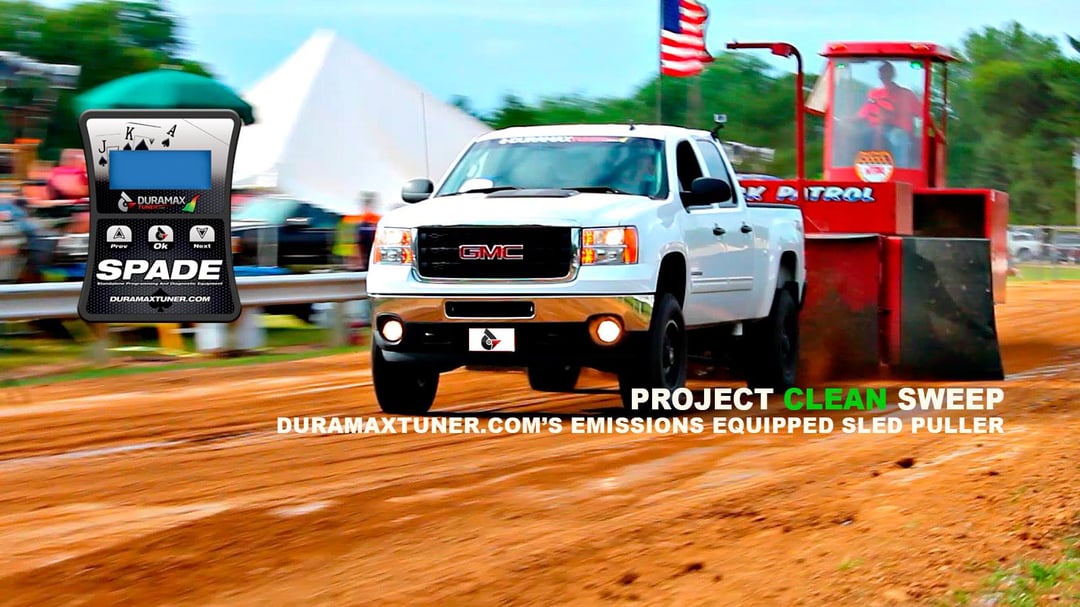No need to delete emissions to make power!
Many people looking to make more power with a 2011 and newer LML Duramax think an aftermarket exhaust is required to make power. This is simply not true! Countless people reach over 500 RWHP with just the LML SPADE and a lift pump.

The most common myths about making power with an LML Duramax:
- "The DPF is going to fail"
- "Higher hp tunes will plug up the filter"
- "I deleted my truck and now I get better MPGs"
It is easy to see why people dislike the emissions equipment.
Back in 2007.5 when all US diesel pickups were forced to include a DPF (diesel particulate filter) and the EGR (exhaust gas recirculation valve) with their trucks, emissions in general got a bad wrap. The first generation of emissions technology was terribly unreliable. The DPF was too small, the EGR failed to often and is was very expensive to repair. This led many people to simply putting a "delete tune" on the truck with a straight pipe and blocking the EGR. Admittedly, this was a simple fix for the time.
Truck owners found that when they deleted the emissions they improved fuel mileage, made more power, and broke down less often. The reality of the situation is that gains in MPG and power come from tuning, not from deleting emissions equipment. Back then not many people thought about tuning until there was a mechanical breakdown, so they never had a chance to run a DPF ON tune and a Delete tune on the same truck. This skewed comparison has been the foundation for many people's future build list.
However DuramaxTuner.com now knows there are better options! Through our extensive research and actual testing we have proven that you can make clean power without having the same issues as the first generation of diesel emissions equipment. The new LML DPF is twice the size of the old LMM DPF, the ERG is an improved design, and the DEF (diesel emmissions fluid) works in the newer models.

Below you will find the most commonly asked questions about Emissions Intact Tuning.
1. How often does the truck go into regen?
Our experience has been that there are 2 common triggers for regen. The truck will initiate regen once it reaches 44 grams of soot in the trap or travels ~700 miles since the end of the last regen. Whichever of these events occur first will start a regen. The regen seems to last until the soot load goes below ~10 grams or so and the driving conditions no long promote regen.

2. How long does it take to regen?
Our test trucks average about 1 mile per gram of soot. So if the DPF is at 44 grams, and regens down to 5, it generally takes about 40 miles. Of course it'll take longer if the cycle is interrupted.
3. How quickly does soot accumulate?
It depends on usage. On the highway, it may be 1 gram every 25-30 miles. Mixed driving might be closer to 20 miles, and of course on the dyno things move a little faster. The weird thing is that the counter jumps quickly between 1-10 grams (maybe one gram per mile), counts slower from 10-19 grams (10 miles/gram), and then seems to count from 20-up much slower (20-30 miles/gram)
4. How much extra fuel does regen take?
My best guess comes from the mileage adjustment I see under steady state operation. For instance. My trip this weekend averaged 19.7 MPG mixed over 700 miles. The truck entered regen at 700 and regen-ed for 40 miles. At the end of regen the DIC showed 19.2 MPG. If I'd done the 740 mile trip without regen at 19.7 MPG, I would have used 37.56 gallons. At 19.2 MPG, I used 38.54 gallons - a difference of about a gallon or 2.6% more fuel.
5. Does tuning affect regen frequency?
Of course it does. The tune needs to be clean for the regen frequency to be kept in check. Our tunes are as clean or cleaner than stock. This 515HP tune has managed 700 miles between regens during road tests. Even driving the truck aggressively seems to have very little affect on the soot counter. The early tunes I tested on dyno seemed to load the soot trap very quickly on the higher HP settings (superchips/HS/Hypertech). If driven reasonably, they intervals weren't noticeably longer - but if hot-rodded, you could expect the soot counter to move quickly.
6. What kind of Mileage can I expect?
Mixed driving can mean many different things to different people. With that said, a single wheel truck can generally manage 16-18 MPG mixed on stock tires with a reasonable driver. On the highway, MPG numbers as high as 23 MPG can be achieved at cruising speeds near 60MPH. As speed increases past 70 MPH, mileage closer to 20/21 is the norm. Colder temps will hurt mileage, especially if the truck is short-tripped.
If you would like to see the math on deleting the emissions equipment download the calculator below:





